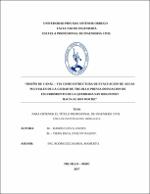Mostrar el registro sencillo del ítem
Diseño de canal - vía como estructura de evacuación de aguas pluviales de la ciudad de Trujillo previa desviación de escurrimiento de la quebrada san Idelfonso hacia el rio moche
| dc.contributor.advisor | Rodriguez Ramos, Mamerto | |
| dc.contributor.author | Ramos Cueva, Dante | |
| dc.contributor.author | Viera Baca, Evelyn Juleisy | |
| dc.creator | Ramos Cueva, Dante | |
| dc.date.accessioned | 2019-10-02T14:04:10Z | |
| dc.date.available | 2019-10-02T14:04:10Z | |
| dc.date.issued | 2019 | |
| dc.identifier.uri | https://hdl.handle.net/20.500.12759/5501 | |
| dc.description.abstract | En los últimos años en la ciudad de Trujillo, como en todo el norte peruano, se viene suscitando grandes inundaciones debido a la llegada del fenómeno del Niño. Y esto genera grandes daños económicos y pérdida de vidas humanas, sin embargo, se ha hecho poco o casi nada por crear o diseñar sistemas de mejor evacuación de estas aguas pluviales para reducir su efecto. En lo que respecta a la ciudad de Trujillo este año 2017 en el mes de marzo nos ha tocado vivir los efectos de este fenómeno de sobremanera, sufriendo los mismos efectos del año 1998, pero con mayor intensidad y mayor tiempo de estadía. Con el presente estudio se pretende calcular el área de cuenca y su caudal máximo de precipitación que se da en la lluvia más intensa en tiempo más largo, para poder calcular el caudal máximo y su velocidad en el punto de desemboque al mar. Y poder determinar el área de la sección requerida para conducir este caudal en el nivel más crítico. Con los datos obtenidos en esta investigación se puede contribuir de manera preliminar al diseño definitivo de un sistema de drenaje capas de evacuar el 100% de estas precipitaciones pluviales, como también servir como una vía de transporte en ausencia del fenómeno y demostrar la dimensión real de esta estructura. | es_PE |
| dc.description.abstract | In recent years in the city of Trujillo, as in the entire Peruvian north, there has been great flooding due to the advent of the Niño phenomenon. And this generates great economic damages and loss of human lives, however little or nothing has been done to create or design systems of better evacuation of these rainwater to reduce its effect. With regard to the city of Trujillo this year 2017 in March we have had to live the effects of this phenomenon very much, suffering the same effects of 1998, but with greater intensity and longer time of stay. The aim of this study is to estimate the basin area and its maximum precipitation flow in the most intense rainfall in the longest time, in order to calculate the maximum flow rate and its velocity at the point of discharging into the sea. And be able to determine the area of the section required to conduct this flow at the most critical level. With the data obtained in this research it is possible to contribute in a preliminary way to the final design of a drainage system layers to evacuate 100% of these rainfall, as well as serve as a transport route in the absence of the phenomenon and demonstrate the real dimension of this structure. | en_US |
| dc.description.uri | Tesis | es_PE |
| dc.format | application/pdf | |
| dc.language.iso | spa | es_PE |
| dc.publisher | Universidad Privada Antenor Orrego | es_PE |
| dc.relation.ispartofseries | T_ING.CIVIL_473 | |
| dc.rights | info:eu-repo/semantics/openAccess | es_PE |
| dc.rights.uri | https://creativecommons.org/licenses/by/4.0/ | |
| dc.source | Universidad Privada Antenor Orrego | es_PE |
| dc.source | Repositorio Institucional - UPAO | es_PE |
| dc.subject | Evacuación | es_PE |
| dc.subject | Pluviales | es_PE |
| dc.title | Diseño de canal - vía como estructura de evacuación de aguas pluviales de la ciudad de Trujillo previa desviación de escurrimiento de la quebrada san Idelfonso hacia el rio moche | es_PE |
| dc.type | info:eu-repo/semantics/bachelorThesis | es_PE |
| thesis.degree.level | Título Profesional | es_PE |
| thesis.degree.grantor | Universidad Privada Antenor Orrego. Facultad de Ingeniería | es_PE |
| thesis.degree.name | Ingeniero Civil | es_PE |
| thesis.degree.discipline | Ingeniería Civil | es_PE |
| dc.publisher.country | PE |
Ficheros en el ítem
Este ítem aparece en la(s) siguiente(s) colección(es)
-
Ingeniería Civil [1149]


